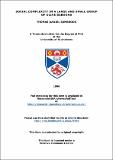Files in this item
Social complexity in a large and small group of olive baboons
Item metadata
| dc.contributor.advisor | Whiten, Andrew | |
| dc.contributor.author | Sambrook, Thomas Daniel | |
| dc.coverage.spatial | 224 | en_US |
| dc.date.accessioned | 2015-04-16T12:59:58Z | |
| dc.date.available | 2015-04-16T12:59:58Z | |
| dc.date.issued | 1996 | |
| dc.identifier | uk.bl.ethos.574654 | |
| dc.identifier.uri | https://hdl.handle.net/10023/6498 | |
| dc.description.abstract | Group size is known to correlate with various indices of brain size in the primates. The possibility that increases in group size foster social complexity forms the central empirical topic of this thesis. A ten month field study of olive baboons, Papio cynocephalus anubis, was carried out on the Laikipia Plateau, Kenya. Data were collected on a wide range of social behaviours in two troops, one smaller than the mean group size for Papio and one larger. The concepts of complexity and social complexity are critically examined with a view to their quantification in behaviour and cognition. The status of social complexity in the debate concerning the evolution of high intelligence in the Primate Order is discussed. Dimensions of social complexity are developed and then investigated empirically. Females in the two troops showed similar grooming frequencies and grooming network sizes. However, the troops differed in the patterning of their grooming with respect to rank: individuals in the small troop groomed those of high rank, individuals in the large troop groomed those of rank similar to themselves. Cluster analysis of spatial proximities showed no sign of cliquishness in either troop. Females formed associations with particular males ('friendships') in both troops but there were no clear differences in either the number or stability of these associations. The rate of interaction was higher in the large troop, but, proportional to total interaction rates, the rates of agonistic and polyadic interactions were not. The rate of interaction was higher for adult and sub-adult females than for adult and sub-adult males. In comparison, the proportion of interactions that were agonistic was greater for the adult and sub-adult males. The variability of response to affiliation that individuals faced was the same across the two troops. Males, however, faced more variability than did females largely because of a high number of avoidant responses. The absence of strong differences in social complexity between differently sized troops suggests that, proximally, cognitive complexity limits social complexity. Thus, interspecific comparisons may prove to be the most fertile area of research into complexity in the future. | en_US |
| dc.language.iso | en | en_US |
| dc.publisher | University of St Andrews | |
| dc.rights | Creative Commons Attribution-NonCommercial-NoDerivatives 4.0 International | |
| dc.rights.uri | http://creativecommons.org/licenses/by-nc-nd/4.0/ | |
| dc.subject.lcc | QL737.P93S2 | |
| dc.title | Social complexity in a large and small group of olive baboons | en_US |
| dc.type | Thesis | en_US |
| dc.type.qualificationlevel | Doctoral | en_US |
| dc.type.qualificationname | PhD Doctor of Philosophy | en_US |
| dc.publisher.institution | The University of St Andrews | en_US |
This item appears in the following Collection(s)
Except where otherwise noted within the work, this item's licence for re-use is described as Creative Commons Attribution-NonCommercial-NoDerivatives 4.0 International
Items in the St Andrews Research Repository are protected by copyright, with all rights reserved, unless otherwise indicated.


